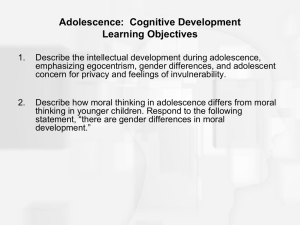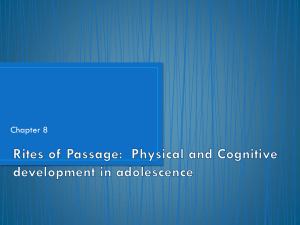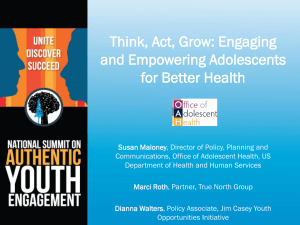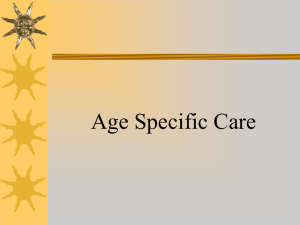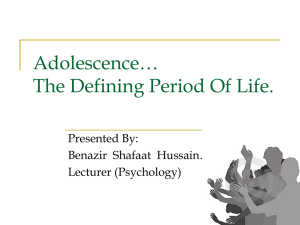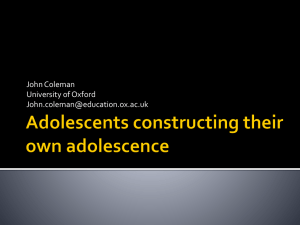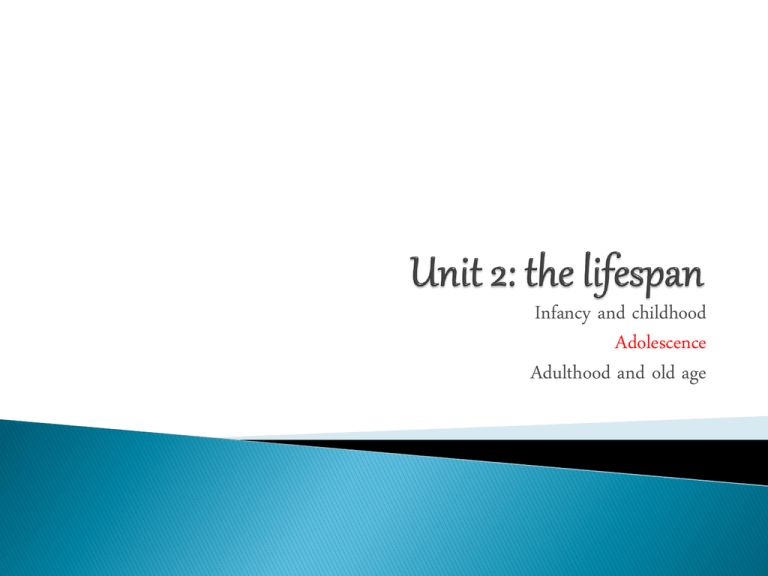
Infancy and childhood
Adolescence
Adulthood and old age
Physical and Sexual Development
Personal Development
Social Development
Gender Roles and Differences
Main Idea
Vocabulary
◦
◦
◦
◦
All adolescents experience dramatic changes in their
physical size, shape,, and capacities, as well as biological
development related to reproduction.
Initiation Rites
Puberty
Menarche/Spermarche
Asynchrony
Objectives
◦ Describe the physical changes that characterize
adolescence.
Theories of adolescence:
Storm and stress (Hall) (1904)
•Was something like being a fully grown
animal in a cage, an animal that sees
freedom but does not know quite when
freedom will occur or how to handle it.
•Thus being confused, troubled, and
highly frustrated.
Cultural (Mead) (early 1920-1930)
- Others have disagreed with (Hall)
- Mead found that in some cultures, adolescence
is a highly enjoyable time of life and not at all
marked by storm and stress.
- She proposed that adolescent storm and stress
was a by-product of an industrialized society.
- Proposed that culture might play a role in
development.
Developmental tasks that must be mastered
(Havighurst):
• Accept body & acquire masculine or feminine gender role
• Develop appropriate relations with peers of both sexes
• Become emotionally independent of parents / adults
• Expect financial independence
• Choose, prepare for and enter a vocation
• Develop cognitive skills & concepts -> social competence
• Understand and achieve socially responsible behavior
• Prepare for marriage and family
• Acquire appropriate values
Initiation rites: Ceremonies or rituals in
which an individual is admitted to new
status or accepted into a new position.
These mark admission into adulthood,
these rites include;
- Birthdays 16-18, graduations, drivers
license, wedding, etc.
Create a timeline of your life
- Conception – 16? 17? 18?
-Include important “initiation rites”, “important times in your
life”. Ex. 16th birthday, first period, etc.
-Think back over stages of your life from childhood to present.
Think of the best and worst times of your life.
- Create a timeline on poster paper
-Must have minimum of 15 points, max 30.
-Include pictures
-MUST BE NEAT!!
Miss Smaluck will be the only one to see this!
• Puberty = Sexual maturation (end of
childhood)
• Girls physically mature faster: early as 8
• Boys physically mature : around 9-10
• Girls Puberty: 8-10
• Boys Puberty: 9-16
• Menarche = first menstrual period
• Spermarche = first ejaculation
• Issues
• Asynchrony: uneven growth
Reaction to growth:
- In general, young people today are better
informed than they were two or three
generations ago.
- Most do not find these changes upsetting.
- But.. Bodily changes that occur during
puberty make all adolescents some what
self-conscious.
- “What for acceptance”
- Boys: tend to be very shy about undeveloped
genitals, lack of pubic hair, or fatty breasts.
- Girls: are likely to be disturbed by underdeveloped
breast or dark facial hair.
- Individual differences in growth greatly affect the
personality of young adolescents.
- Example, research indicates
Boys who mature early have an advantage.
-They become heroes in sports and leaders in
social activities, other boys look up to them, girls
have crushes on them, adults tend to treat them
as more mature.
Late maturing boys may withdraw or exhibit deviant
behavior.
Girls who mature early:
-May feel embarrassed rather than proud of their
height and figure at first.
-Some begin dating older boys and become bossy with
people their own age.
Late maturing girls:
- Tend to be less bossy and may get along with their
piers more easily.
Section Quiz 4-1
Journal Entry#6
Discussion “whether adolescents is a time of “ storm and stress”
Main Idea
The transition from childhood to adulthood involves
changes in patterns of reasoning and moral thinking, as
well as the development of ones identity.
Vocabulary
◦ Rationalization
◦ Identity Crisis
◦ Social Learning
Objectives
◦ Describe the cognitive and ideological changes that
characterize adolescence.
◦ Outline the process by which adolescents find a
personal identity.
During adolescence, a sense of identity and
self-esteem are very important and depend
very much on friends.
Many changes are occurring in ways of
thinking and feeling.
The transition from childhood to adulthood
also involves changes in patterns of
reasoning and moral thinking, and
adjustment in personality and sexual
behavior.
1. Cognitive Development
During adolescence, the thinking patterns
characteristics of adults emerge.
Jean Piaget described this as formal
Operations thinking.
From about age 11 or 12, most people’s
thinking becomes more abstract.
◦ Ex, Adolescence can now answer hypothetical questions like “what
would the world be like if people lived to 200?”
Complete graphic organizer 4
http://www.youtube.com/watch?v=YtLEWVu815o&list=PLZ
uo2yGmEwq-AudV0yEJDY2F6NhFJ3Tvs
Complete Graphic Organizer 3
With comprehension of the hypothetical come the ability to
understand abstract principles and deal with analogies and
metaphors.
Allows for introspection – examining one’s own motives and
thoughts.
One adolescents notices, “I found myself thinking
about my future, and then I began to think why I was thinking
about my future, and then I began to think about why I was
thinking about why I was thinking about my future.”
**These new intellectual capacities also enable the
adolescent to deal with overpowering emotional feeling
through rationalization.
Rationalizations: protect self-esteem from
emotions
After failing a test, an individual may
rationalize that it happened “because I was
worried about the date I might be going on
next week.”
Do all adolescents fully reach the stage of
formal operations thinking at the same age?
David Elkind
Adolescent problems due to immature and
abstract thinking (Elkind):
•Finding fault with authority
•Argumentativeness
•Indecisiveness
•Apparent hypocrisy
•Self-consciousness
•Invulnerability
Handout
2. Moral Development
Besides experiencing physical and cognitive
changes, some adolescents, through by no
means all, also go through important
changes in their moral thinking.
Lawrence Kolhlberg- moral reasoning
develops in stages. (question on stealing
drug)
Handout
Overall, psychologists agree that a person’s moral development
depends on many factors, especially the kind of relationships the
individual has with his or her parents or significant others.
Evidence shows that during high school, adolescents moral
development does not progress much. During college, however,
when the individual is away from home more and experiencing
different cultures and ideas, more pronounced changes in moral
edvelopment occur.
3. Identity Development
The changes adolescents undergo affect many factors of
their existence, so it is hardly surprising that
cumulatively that have a shaping influence on
personality.
Erik Erikson has shown that the establishment of identity
is key to adolescent development.
His theory of how individuals arrive at an intergrated
sense of self has inspired a great deal of argument.
Identity crisis (Erikson) – stage: identity vs role
confusion (Who am I?)
Identity Crisis – a period of inner conflict during which adolescents
Worry intensely about who they are.
Identity categories (Marcia):
• Moratorium (considering but no decision)
• Foreclosure (decision but not their own)
• Confused (not considering and no
decision)
• Achievement (considered and decided)
Section Quiz 4-2
Main Idea
◦ Adolescents undergo many changes in their social
relationships, adjusting to new relationships with
parents and the influence of peers.
Vocabulary
◦
◦
◦
◦
Clique
Conformity
Anorexia Nervosa
Bulimia Nervosa
Objectives
◦ Describe the role of family and peers during adol.
◦ Describe difficulties that some adol. encounter.
Adolescents experience various changes in their social
relationships.
No longer a child though not yet an adult, the teenager must
find a new role in the family – one that parents are not always
ready to accept.
He or she must also adjust to new, often more intense
relationships with peers.
Adolescents can trust their peers not to treat them like children.
Teenagers spend most of their time with friends –they need and use
each other to define themselves.
Most schools contain easily recognizable and well-defined groups.
Everyone knows who belongs to which group.
Early adolescents the groups are usually divided by sex, but later
the sexes mix.
Groups usually from along class lines, “upper, middle, lower.”
Discuss at table – how many groups at Drcss?
Besides class, what determines whether an adolescent will be accepted
by a peer group?
-Personal Characteristics: popularity is based on good looks and
personality.
Belonging to a clique (a group within a group) is very important to most
adolescents and serves several functions.
- Need of closeness with others, means of finding themselves,
“creating an identity”
Belong to a group allows for individuals to achieve self confidence,
sense of independence from family, clarify values, etc.
Member of a clique may imitate clothing, speech, or even hair styles.
Draw backs till this type or organization?
-One of the greatest is fear of being disliked, which leads to
conformity ( acting in accordance with some specific
authority).
-A teenager’s fear of wearing clothes
that might set him or her apart from
others is well known!
Despite their tendency to encourage conformity, peer groups are
not always the dominant influence in an adolescents life.
Both parents and peers exercise considerable influence in shaping
adolescent behavior and attitudes.
Peers tend to set the standards on such matters as fashion and taste
in music.
Parents usually advise on school related issues.
When it comes to basic matters, involving marriage, religion, or
education, adolescents usually accept their parents beliefs.
Issues:
◦ Depression
What events trigger depression in
adolescents?
Depression
◦ triggered by breakdown of family unit
◦ loss of loved ones
◦ express anger vs sadness on adults
How to deal: Communication about problems.
Issues:
◦ Eating Disorders
What events triggers eating disorders in
adolescents?
Eating disorders:
Anorexia – fear of gaining weight that
results in prolonged self starvation
and dramatic weight loss.
Bulimia – compulsive overeating
usually followed by self induced
vomiting or abuse of laxatives.
*More common in females
Delinquency (running away from home, teen
pregnancy, alcohol/drug abuse,
underachievement at school)
Suicide (tripled in past 50 years, troubled
teens don’t simply “outgrow problems,
warning signs, hotlines)
Section Quiz 4-3
Main Idea
◦ Females and males have physical and psychological gender
differences. Our beliefs about what we think it means to be
male and female influence our behavior.
Vocabulary
◦
◦
◦
◦
Gender Identity/ Gender Role
Gender Stereotype
Androgynous
Gender Schema
Objectives
◦ Explain the difference between gender identity and gender
role.
Application activity 4 “Gender Role Characteristics”
Gender Identity = physical & biological makeup
Gender Role influenced by gender identity,
society, and culture
Differences (aggression – women indirect, cognitive
Androgyny (Bem)
ability – women hedge, math and verbal the same but men
more confident), stereotypes (overgeneralized)
Many people just take for granted the differences between boys and
girls, claiming “boys will be boys,” or something similar.
Pick up a magazine, turn on the TV, or look outside you windowgender stereotypes are everywhere.
Baby girls – pink
Baby boys – blue
Your gender greatly influences how you dress, move, work, and
play.
Do children learn gender identities or are they born different?
Gender Identity: is ones physical and genetic makeup. It is your
awareness of being female or male.
Thus, is one has a vagina, one’s gender identity is female, if a
penis, male.
Between the ages of 2 and 3, most children learn to label
themselves as boys and girls.
By age 5, most children have learned the thought, expectations,
and behavior that accompany their gender role.
A Gender Role is defined partly by genetic makeup but mainly
by the society and culture in which the individual lives. “How
females and males are viewed in society.”
Ex. In the United States, me were traditionally viewed as
dominant, competitive, and emotionally reserved; women were
viewed as submissive, cooperative, and emotionally responsive.
Gender Stereotypes: are oversimplified or prejudice opinions
and attitudes concerning the way men and women should
behave.
Androgynous: Roles that involve a flexible combination of
traditionally male and female roles.
Not all people accept the more androgynous gender roles. Older
people especially may still be guided by traditional ideas about
gender roles
https://www.youtube.com/watch?v=0nIXUjzyMe0
Study found that males are more confident that females, especially in
academic areas or in tasks stereotypes as masculine, such as math and
science
Many studies have also found aggression is one of the areas with the
most significant differences between genders. Females more verbal
aggressive, males more physical aggression.
Another gender difference can often be detected in male and female
communication. Women are more likely to use hedges in speech, such
as “kind of” or “you know”. Woman also use disclaimers, such as “I
may be wrong”, or “I’m not sure.”
You may have heard females are better than males at verbal
skills, while males excel at spatial and mathematical skills.
Janet Hyde and Marcia Linn (1988 studies 165 studies) found
no measurable differences.
Specific topics and age trends, some differences do appear.
Males and females perform about the same in problem solving
until high school, at that point males out perform females.
Males tend to do better on spatial awareness, females better at
tracking objects. (Figure 4.15)
Theories:
◦ Biological (anatomy, hormones, brain, evolution)
◦ Psychoanalytic (identification)
◦ Social learning (observation & imitation of models)
◦ Cognitive-development (learning from
experience, development of gender schema)
Section Quiz 4-4





